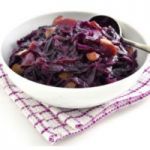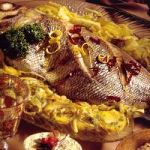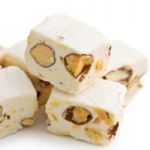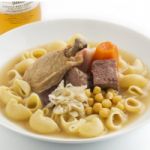 |
Spanish Holiday Traditions fragrant with dried fruits and olive oil
In Spain, even though the tendency is to pull out all the stops for the Christmas meal, there is no one particular Christmas menu to speak of. Even if there are certain foods that are invariably present, such as touron, a kind of nougat, or to a lesser extent seafood, it is an occasion for the great variety of regional cuisines to shine, enhanced by local products ranging from saffron to olive oil, from Iberian ham to sherry vinegar.
Upon closer examination, it is interesting to note that three of the four recipes presented on the traditional menu make use of dried fruits and nuts: almonds in the soup and the touron, and pine nuts to accompany the red cabbage. The use of fruits and nuts is part of the gastronomic legacy of the Arabs, who were present for almost eight centuries in much of what is now Spain. The cuisine of Al Andalus made a definite impact on Spanish cuisine, by introducing to it the cultivation and use of many products such as rice, oranges, and especially almonds.

Speaking of almonds, you may be surprised to find almond soup, a creamy concoction midway between sweet and savoury. Though it is generally served as a dessert in all parts of Castile throughout the year, at Christmas it is served as soup, flavoured with saffron, that almost mythical spice which has found perfect growing conditions in Spain, especially in La Mancha. There, every autumn, the saffron flowers are picked, and then in a process carried out completely by hand, the stigmas are toasted to produce the finest saffron in the world, known as "Calidad Mancha."

Red cabbage needs no introduction. This gaily-coloured winter vegetable is found on the menu of many Christmas meals, simply boiled and then sautéed with garlic. In our recipe, the combination of pinenuts, raisins and Ribera del Duero wine gives even more refinement and depth of flavour to this brilliantly coloured vegetable, joining to produce a happy combination on the Catalan table.

From vegetables, let's move on to fish. Spain is, after Japan, the second largest consumer of fresh fish in the world. Fish is eaten not only in the coastal towns, but also in the interior, and remains a traditional Christmas food in many households. Though dorado, from the Cantabrian and Galician coasts, is a bit expensive (and at Christmas time commands the price of gold), all of Spain allows itself to be seduced by this fine fish which will be grilled and served on a bed of thinly sliced potatoes and onion rings, garnished with the traditional persillade of parsley, garlic and saffron. Just before being served, it will be sauced with a mixture of Sherry and peppers. In the Basque country, a few cloves of garlic, thinly sliced and sautéed in oil, are added.

The only way to round out this classic menu is with touron, a nougat of Arabic origin made with almonds and honey or sugar, without which it would just not be Christmas in Spain. There are innumerable variations - chocolate, coconut, praline, etc. - but the oldest and most authentic recipes are those for soft (Jijona) touron, made with ground almonds, or hard (Alicante) touron, made with whole almonds, or served as an ice cream, accompanied by chocolate sauce. The sauce is made not with butter but with olive oil, as it used to be made when cocoa was first brought to Spain from the Americas.

Feliz Navidad
Red cabbage with Ribera del Duero wine
Sea Bream with saffron and sherry
Touron ice cream (ice cream made with two nougats) with chocolate sauce
Breadcrumb doughnuts in rosemary honey syrup
Bitter orange or Seville orange peels in syrup

-

 Recipes
Recipes
-

 Products
Products
-

 Entertaining
Entertaining
-

 Chefs
Chefs
-

 Hints & Tips
Hints & Tips
-

 Glossaries
Glossaries








